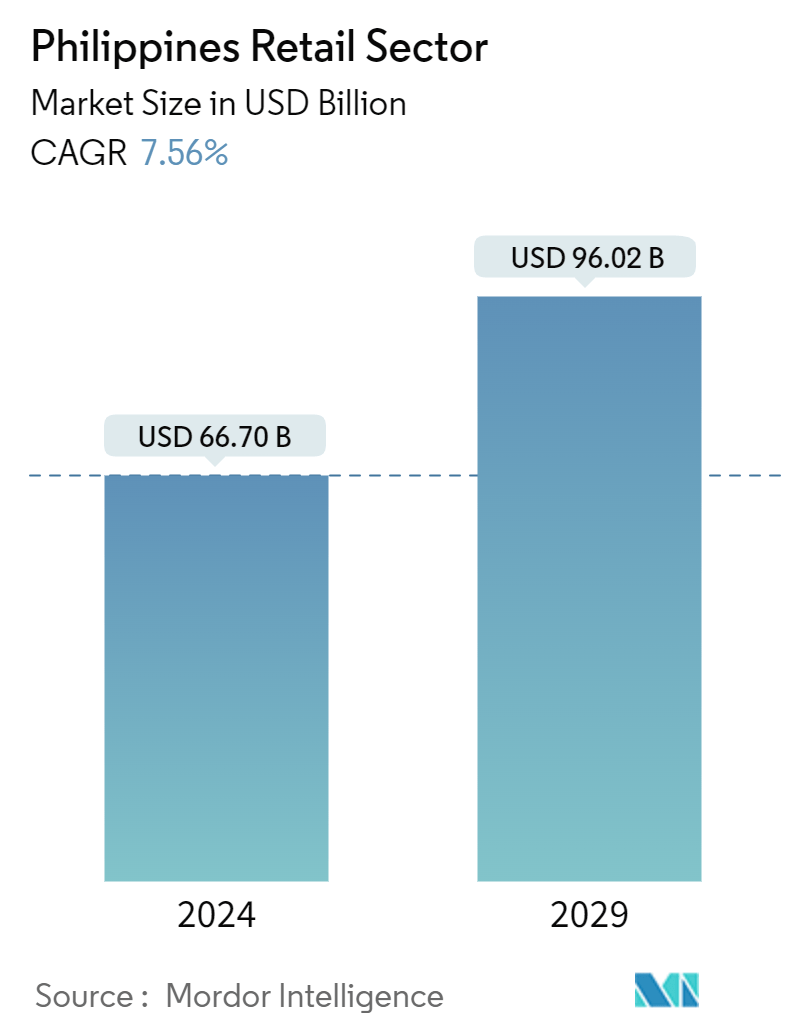Market Size of Philippines Retail Sector

| Study Period | 2020 - 2029 |
| Base Year For Estimation | 2023 |
| Market Size (2024) | USD 66.70 Billion |
| Market Size (2029) | USD 96.02 Billion |
| CAGR (2024 - 2029) | 7.56 % |
| Market Concentration | Low |
Major Players
*Disclaimer: Major Players sorted in no particular order |
Need a report that reflects how COVID-19 has impacted this market and its growth?
Philippines Retail Market Analysis
The Philippines Retail Market size is estimated at USD 66.70 billion in 2024, and is expected to reach USD 96.02 billion by 2029, growing at a CAGR of 7.56% during the forecast period (2024-2029).
The demand for convenience food products is a key driver behind the robust growth of the retail market in the Philippines. These products, requiring minimal preparation, have become popular choices, especially among busy individuals and the rising working female population, who are opting for convenience foods like processed meats and poultry over home-cooked meals.
The retail landscape in the Philippines is witnessing a notable upswing, with industry players capitalizing on the buoyant growth rates across diverse retail segments. Luxury goods, in particular, are poised to be the frontrunners in Southeast Asia, with an estimated growth rate of 30%. Additionally, the retail e-commerce sector in the Philippines is set to outpace its counterparts in Southeast Asia. This retail surge is largely attributed to the expanding supply and distribution networks, facilitating enhanced accessibility to various goods and services for consumers.
Philippines Retail Industry Segmentation
Retail involves the direct sale of products and services to individual consumers.
The Philippine retail sector is segmented by products and distribution channels. By product, the market is segmented into food and beverages, personal and household care, apparel, footwear and accessories, furniture, toys and hobbies, electronic and household appliances, and other products, and by distribution channel, the market is segmented into supermarkets/hypermarkets, convenience stores, and department stores, specialty stores, online, and other distribution channels. The report offers the market size and forecasts for the Philippine retail sector in value terms (USD) for all the above segments.
| By Products | |
| Food and Beverage | |
| Personal and Household Care | |
| Apparel | |
| Footwear and Accessories | |
| Furniture | |
| Toys and Hobbies | |
| Electronic and Household Appliances | |
| Other Products |
| By Distribution Channel | |
| Supermarkets/Hypermarkets | |
| Convenience Stores | |
| Department Stores | |
| Specialty Stores | |
| Online | |
| Other Distribution Channels |
Philippines Retail Sector Size Summary
The retail industry in the Philippines is experiencing significant growth, driven by the increasing demand for convenience food products and the expansion of e-commerce. The rise in disposable incomes, particularly among the middle and upper classes, is fueling consumer spending, with the 25-34 age group leading in discretionary purchases. The food and beverage sector plays a crucial role in the economy, contributing substantially to the GDP and benefiting from the proliferation of restaurants, fast food chains, and food delivery services. The shift towards online shopping, accelerated by the COVID-19 pandemic, has transformed consumer behavior, with platforms like Lazada, Shopee, and Foodpanda gaining prominence. This digital shift is also encouraging the adoption of digital payment services, enhancing the accessibility of goods and services across the country.
The Philippine retail market is characterized by its fragmented nature, with a few major players dominating the landscape while smaller stores gradually give way to larger formats such as supermarkets and hypermarkets. Companies like SM Investments Corp., SSI Group, Puregold Price Club Inc., Metro Retail Stores Group Inc., and Robinsons Retail Holdings Inc. are leading the charge in this transformation. Recent developments, such as Rose Pharmacy's expansion and Robinsons Retail's collaboration with DFI Retail, highlight the ongoing evolution of the sector. These initiatives reflect a broader trend towards offering diverse product ranges and enhancing consumer experiences, positioning the Philippine retail industry for continued growth in the coming years.
Philippines Retail Sector Market Size - Table of Contents
-
1. MARKET INSIGHTS AND DYNAMICS
-
1.1 Market Overview
-
1.2 Market Drivers
-
1.2.1 The Rising Demand for Packaged and Ready to Eat Food is Driving the Market
-
1.2.2 Increase in the Demand for Branded Goods Categories such as Apparel, Cosmetics, Footwear, Watches, Beverages, and Food
-
-
1.3 Market Restraints/Challenges
-
1.3.1 Changing Consumer Buying Behavior and Rising Brand Consciousness
-
-
1.4 Market Opportunities
-
1.4.1 Increase in Internet Penetration Leads to Growth in the Market
-
1.4.2 Virtual Sales Assistants and Rising Digital Payment Options
-
-
1.5 Value Chain/Supply Chain Analysis
-
1.6 Porter's Five Forces Analysis
-
1.7 Consumer Behavior Analysis
-
1.8 Insights into Technological Innovations in the Retail Industry
-
1.9 Impact of COVID-19 on the Market
-
-
2. MARKET SEGMENTATION
-
2.1 By Products
-
2.1.1 Food and Beverage
-
2.1.2 Personal and Household Care
-
2.1.3 Apparel
-
2.1.4 Footwear and Accessories
-
2.1.5 Furniture
-
2.1.6 Toys and Hobbies
-
2.1.7 Electronic and Household Appliances
-
2.1.8 Other Products
-
-
2.2 By Distribution Channel
-
2.2.1 Supermarkets/Hypermarkets
-
2.2.2 Convenience Stores
-
2.2.3 Department Stores
-
2.2.4 Specialty Stores
-
2.2.5 Online
-
2.2.6 Other Distribution Channels
-
-
Philippines Retail Sector Market Size FAQs
How big is the Philippines Retail Market?
The Philippines Retail Market size is expected to reach USD 66.70 billion in 2024 and grow at a CAGR of 7.56% to reach USD 96.02 billion by 2029.
What is the current Philippines Retail Market size?
In 2024, the Philippines Retail Market size is expected to reach USD 66.70 billion.

